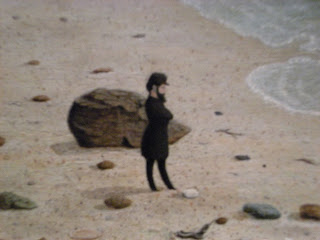Of course, I took particular note of the folk art collection, which was always a strong component of the museum's offerings since their main benefactor, the collector Maxim Karolik (a Russian immigrant who married into the wealthy Codman family of Boston) was a major enthusiast of the works of American self-taught artists. I was delighted to find out that the folk art pieces appear in a number of galleries throughout the new wing, and are also featured in one large gallery on the second floor. While perusing that space, I reacquainted myself with a singular, enigmatic piece that has captivated critics and the public for decades: the unassuming little painting called "Meditation by the Sea."
It'a a wonderful little painting, with all of the bold patterning of forms that make folk art so much fun. But it has more than that. It has an air of mystery and tension that is inescapable. Who is the figure in the foreground? Why is he at this beach? Most important, what is he thinking as he contemplates the sea before him?
The accompanying label offered two tidbits. One, that this painting was based on a print of the beach at Gay Head, Martha's Vineyard, that appeared in Harper's Magazine in the early 1860s. And two, that perhaps the tension and anxiety some see in the picture has something to do with the Civil War going on at the time.
Both ideas are tenuous. I'm reproducing the print here to make my point that there is no conclusive way to say it is the inspiration for the painting. At least not to my eye. This lack of visual connection throws into question, obviously, the latter contention that the mood is related to the Civil War. I'm not sure we know when this picture was painted.
None of this matters, of course, when considering this work as an American masterpiece. It is, unquestionably. It's just a pity we don't know what that little guy is thinking. In the meantime, we can fill in the blanks with our own imaginations, and admire the liveliness of the unidentified artist's brush strokes, which delight the eye, and the composition, which invites us to take a walk on that beach and lose ourselves for a moment or two.







































